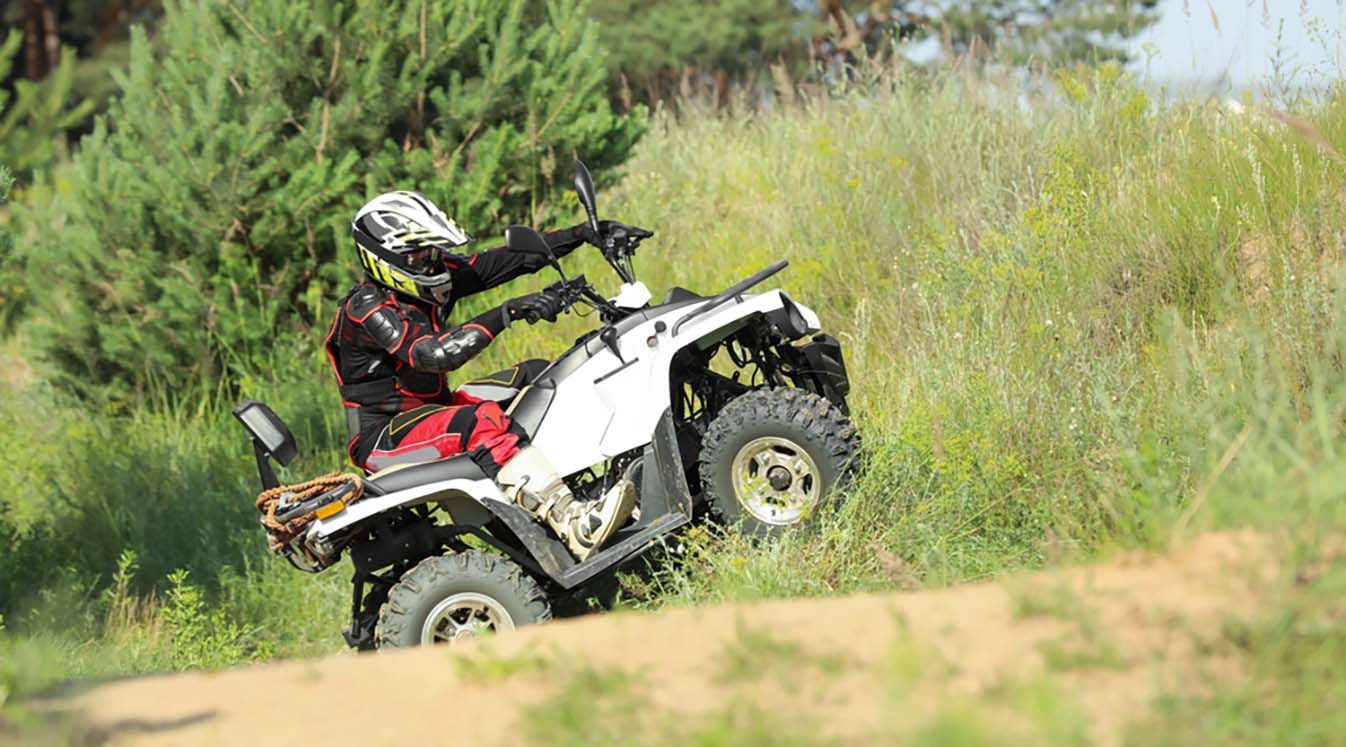Riding an ATV isn’t dangerous if you wear the proper safety equipment and use caution when exploring off-road areas. But many drivers don’t take these precautions, which exposes them to unnecessary risks. Every year, there are some 135,000 individuals injured in ATV accidents in the U.S., and 300 to 400 of these accidents result in fatalities. The truth is that you should be able to enjoy your ATV without worrying about injuring yourself in the process. Use these safety tips to easily make it to and from your destination.
ATV Safety: Know the Risks
Driving any type of motor vehicle involves some risk, but ATVs don’t have seatbelts or interiors to prevent injury. That’s why communication and proper safety equipment is key for ATV riders. These vehicles also have a high center of gravity, which can make them harder to steer. A tight turn can cause the ATV to flip over. Riders can get thrown over the handlebars in a collision. These types of accidents can lead to serious neck, leg, spine and head injuries, resulting in a trip to the emergency room. Exposure to the wilderness can also lead to minor injuries, including scrapes, cuts and insect bites, which is why it’s important to wear long pants and long sleeves.
The Consumer Product Safety Commission (CPSC) advises all riders to understand the risks of riding off-road. State DMV offices oversee ATV registration. They have strict rules for their operation to improve public safety which vary by region.
Other rules include riding one person to a vehicle unless it's designed to carry passengers, not riding under the influence of drugs or alcohol, not riding on public roads unless it’s safe to cross and taking an approved ATV safety course.
Many states don’t require a valid driver’s license to operate an ATV, but that doesn’t mean anyone should hop behind the wheel. Anyone operating this equipment should be fully trained on how to use the vehicle. They should be at least 16 years of age with experience braking, accelerating and turning. An adult must accompany those aged 14 to 15.
Riding in remote areas without supervision can lead some to take unnecessary risks like driving at high speeds, riding more than one person to a vehicle or forgoing the required gear. It’s your responsibility to follow the rules wherever you are.
How to Stay Safe While Riding an ATV
Use Wireless Communication to Stay Safe on the Trail
1. Wear the Proper Attire
Short sleeves and cut-offs have no place on the trail. You should cover as much of your skin as possible when cruising through the wilderness. That means wearing long sleeves, pants, high socks and gloves. Bring sunscreen and bug spray in case the wilderness fights back. You can also wear pads to shield your arms, legs and joints from serious injuries.
You should be able to communicate with your companions at all times when riding an ATV. Talking over the sound of your engine may not be an option, and taking your hands off the wheel to send a hand signal can be a recipe for disaster when the road gets rough.
Wear a wireless communication device to stay in contact with your group for hands-free communication. Just speak into the headset to connect to your group automatically when you’re in range. You can safely coordinate with one another as you explore unfamiliar territory.
2. Drive with Care
Your safety largely depends on how you ride. Your speed, route and the condition of your equipment can all affect your safety. If you’re new to the sport, take a beginner’s course with a trained professional and practice riding in wide open spaces to get your bearings before you head into the wilderness.
It’s never a good idea to take your hands off the handlebars or look away from the trail, which makes it difficult to communicate. Pair your off-road communication device to wirelessly connect to your companions, phone or GPS while riding. Just speak into the device to call for help in an emergency without physically interacting with the device.
Listen for strange sounds and monitor performance to spot potential hazards as they appear.
3. Stay Alert
Riding an ATV exposes you to the elements. You never know when circumstances may change on a dime. Sign up for the latest weather alerts to ensure you always have the latest forecast. Check the map often during your trip to monitor your location. Avoid traveling too far in case the weather takes a turn for the worse.
Use good judgment when exploring the natural world. Slow down even if the path appears clear to give yourself more time to stop. Inspect trail conditions to ensure it’s safe to proceed. Avoid driving through the messiest parts of the trail, including deep bogs, rivers and mud pits, to avoid getting stuck or damaging your ride.
Be Prepared for Outdoor Adventures with an Off-Road Communication System
4. Maintain Your ATV
ATVs endure their fair share of wear and tear. All that mud, excess water and dirt can damage the underlying components of the vehicle. Taking off on an adventure with faulty equipment is never a good idea.
Inspect your vehicle before and after every ride. Clean it regularly to keep moisture and oxidation at bay. Have your ATV inspected by a professional at least once a year to keep on riding. Make repairs and refill the oil regularly to avoid getting stuck in the middle of the forest.
Staying Safe on an ATV
Driving an ATV comes with some risk, but you will be safe if you wear the right equipment and avoid driving in dangerous conditions. You can dramatically reduce your risk of injury and collision by following the rules and avoiding unnecessary risks. The bottom line is that ATV injuries are preventable. Keep these tips in mind to enjoy your time in the wild without worrying about risking your health and safety.





